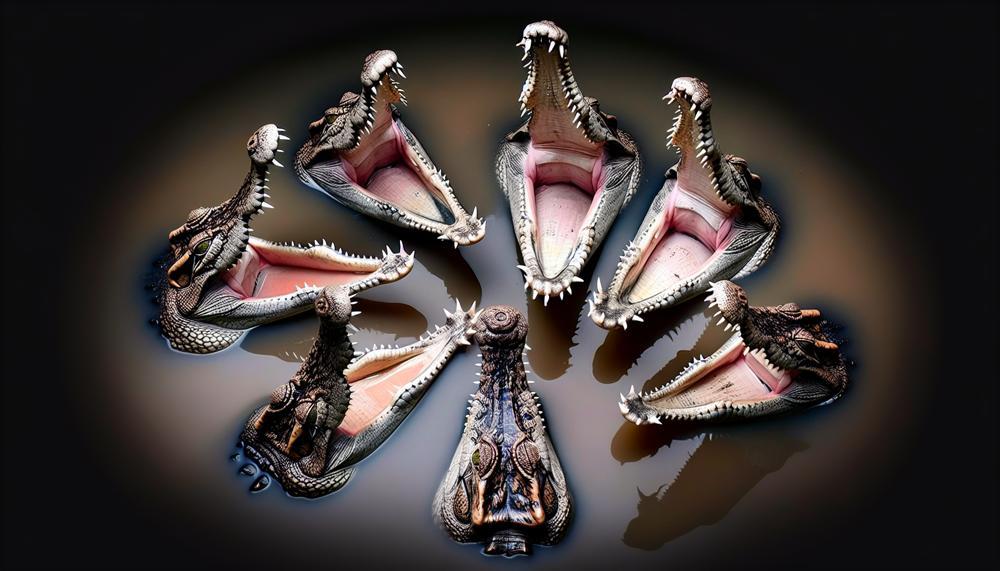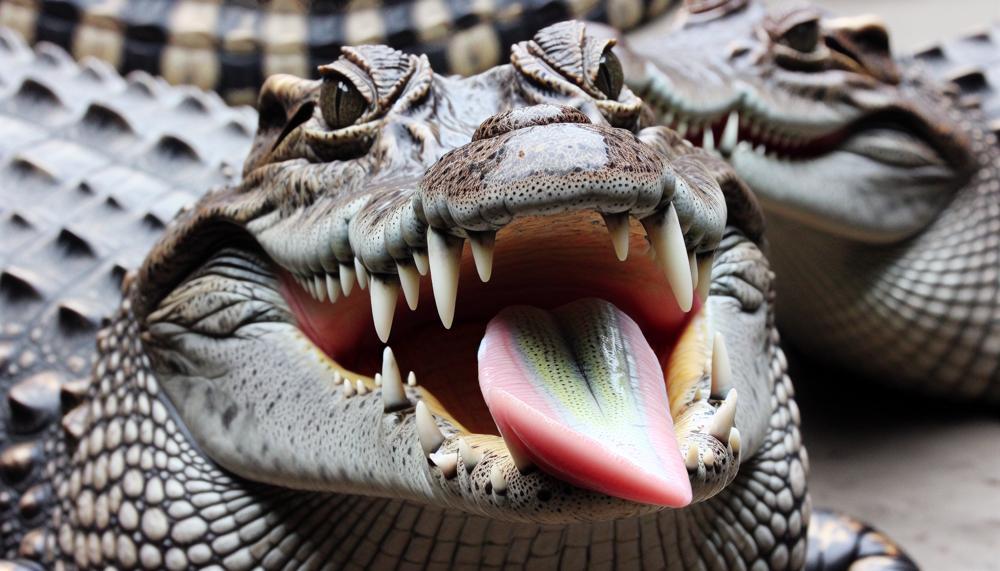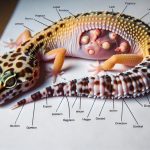Welcome to a journey into the jaws of one of nature’s most enigmatic predators. Today, we’re peeling back the layers of mystery shrouding an often-overlooked aspect of crocodilian biology – the presence and function of their tongues. While these ancient reptiles are well-known for their powerful bite and armored scales, there’s more to their story than teeth and terror.
In this exploration, we’re diving snout-first into the riveting world of crocodile anatomy to answer a question that has puzzled enthusiasts and experts alike.
So, do crocodiles have tongues?
Yes, crocodiles have tongues, but they are not free to move. A membrane at the roof of their mouth holds their tongue in place, making it impossible for them to stick it outside of their narrow mouths. This is because crocodiles primarily hunt by using their powerful jaws to catch and crush their prey, so their tongue is not needed for this purpose. Instead, the tongue helps keep the crocodile’s throat closed, protecting its airway.
Crocodiles spend a lot of time underwater. When their mouth is open, an extension of their tongue covers their throat, making it seem like they usually have no throat.
Let’s start now.
Contents
How do crocodiles swallow their food with an immobile tongue?
Crocodiles are formidable apex predators, known for their powerful jaws and rugged appearance. Despite possessing a robust toolkit for hunting and capturing prey, crocodiles have tongues that are quite distinct from many other creatures; their tongues are fixed to the bottom of their mouths and do not assist in the manipulation or swallowing of food.
Below is an analysis of how crocodiles consume their prey without the aid of a mobile tongue:
Tongue Function in Crocodiles:
- Salt Regulation: Crocodiles have specialized salt glands within their tongues that are essential for surviving in salty environments. These glands actively secrete excess salts, maintaining the balance of body fluids.
- Heat and Moisture Regulation: The tongue also plays a role in regulating body temperature and moisture levels, particularly when crocodiles bask with their mouths open.
Feeding Mechanics:
- Powerful Jaws: Crocodiles rely on their strong jaws and sharp teeth to capture and crush prey. The tongue remains stationary during this process.
- Throat Protection: During underwater ventures, the tongue acts as a valve to block the throat, preventing water from entering the airway.
- Swallowing: When swallowing, crocodiles tilt their heads back to let gravity help move the prey down their throat, since the tongue does not aid in pushing food into the digestive tract.
Here’s a breakdown in table format detailing the components of a crocodile’s feeding process:

| Feature | Function | Role in Feeding |
| Jaws | Capture and crush prey | Main tool for breaking down food |
| Teeth | Sharp for gripping prey | Ensure prey cannot escape |
| Tongue | Salt regulation, heat regulation | Blocks throat underwater, but doesn’t aid in swallowing |
Thus, despite their immobile tongues, crocodiles are adept at consuming their prey by utilizing their powerful jaws to secure and crush their catch, and then leveraging the forces of nature – like gravity – to facilitate swallowing.
If they don’t need their tongue to swallow food, then what do they use it for?
Crocodiles boast tongues that stick to their mouths’ bottoms, a far cry from the wriggly specimen in our own. Nonetheless, these tongues aren’t just taking up space; they’re multi-tasking marvels in their own right.
Here’s the lowdown on these crafty crocodilian tongues:
| Function | Description | Additional Info |
| Airway Protection | Seals off water from entering airways | Acts like a snorkel underwater |
| Thermal and Salt Control | Regulates body temperature and salt intake | Important for crocs in hot environments |
| Taste Detection | Taste buds help locate prey | Located on the upper palate, not the tongue itself |
| Prevention of Self-Injury | Immovable to avoid damage during jaw closure | A safety feature for powerful bites |
| Hydration | Allows for the intake of small amounts of water | A subtle but essential action |
| Culinary Use | Edible and nutritious | High in protein and unsaturated fatty acids |
Keeping water out of the airway while underwater
Crocodiles are fascinating, prehistoric creatures with adaptations that allow them to thrive both on land and water. One of their most intriguing adaptations is the ability to prevent water from entering their airways while submerged.
This is achieved through a combination of anatomical features and physiological mechanisms:
Valvular Flap:
At the back of a crocodile’s throat, there’s a muscular flap called the palatal valve. This valve closes off the crocodile’s throat and airways when it dives, acting as a watertight seal.
Immobile Tongue:
Crocodiles have a unique tongue that is fixed to the bottom of their mouth, further aiding in sealing their mouth shut and preventing water from entering their airways.
Diving Reflex:
Upon submersion, crocodiles exhibit a diving reflex where their bodily functions slow down, and the palatal valve automatically engages, ensuring that the airway remains closed.
Taste Buds on Upper Palate:
The taste buds located on the upper surface of a crocodile’s tongue help them to sense their prey without the need to open their airway, thus maintaining the seal against water ingress.
How Crocodiles Regulate Salt Intake
Crocodiles are remarkable creatures with the ability to thrive in both freshwater and saltwater environments.
This adaptability hinges on their sophisticated osmoregulation systems. Here’s how they maintain the delicate salt balance in their bodies:
Saltwater Survival Strategies
In saltwater habitats, crocodiles face the challenge of osmotic dehydration due to the high salt concentration. They combat this by excreting excess sodium and chloride ions. This osmoregulatory process is facilitated by:
- Specialized Cells: Cells in their tongue and other organs have ion pumps that actively expel salt from their bloodstream.
- Salt Glands: These glands, located near the crocodile’s tongue, function similarly to human kidneys but are significantly more efficient at expelling salt.
Freshwater Adaptations
When dwelling in freshwater, crocodiles encounter the opposite problem: they risk diluting their body fluids with too much water. To avert this, they:
- Retain Ions: Specialized cells work to transport valuable ions back into the body to uphold ionic balance.
- Modify Kidney Function: Their kidneys adapt to conserve essential salts while still flushing out wastes.
The Osmoregulatory Machinery
Crocodiles rely on various structures to regulate their internal salt concentrations:
| Structure | Function | Role in Osmoregulation |
| Vacuoles | Storage | Contain and transport ions within cells |
| Flame Cells | Filtration | Filter out waste from the bloodstream |
| Malpighian Tubules | Waste Excretion | Remove nitrogenous waste and regulate ion balance |
| Kidneys | Water and Ion Regulation | Adjust water and salt levels, depending on the environment |
Crocodiles’ osmoregulatory processes are a testament to their evolutionary prowess, allowing them to dominate a variety of aquatic realms.
To Regulate Body Heat
Crocodiles are masters of thermoregulation, using their tongues in a unique way to keep cool. Unlike other creatures, they can’t pant or sweat; instead, crocs have a nifty trick up their sleeve. When the heat’s turned up, they gape wide, letting the air kiss their moist tongue. This isn’t just for show; it’s their version of an air-con.
The moisture on the tongue evaporates, and presto. They chill from the inside out.
Thermoregulation Tactics
Crocodiles use a variety of strategies to manage their body temperature:
- Basking in the sun: To warm up, they’ll lounge in the sun, absorbing its heat.
- Shade-seeking: When it’s too hot, they’ll find a nice shady spot to cool down.
- Gular fluttering: This is where the tongue comes into play. They’ll open their mouth and the breeze over the wet tongue cools blood flow, reducing their body temperature.
| Method | Description | Purpose |
| Gaping | Crocs open their jaws wide | Allows air to flow over the tongue and promote evaporative cooling |
| Moist tongue surface | Tongue remains wet inside the open mouth | Increases surface area for evaporation |
| Gular fluttering | Slight movement of the floor of the throat | Enhances air circulation for better cooling |
So, when you spot a croc with its mouth agape, it’s not sizing you up for supper—it’s likely just throwing some shade at the sun’s heat. And remember, this cool trick is just one slice of their survival pie. Their tongues are multitaskers, dealing with salt and heat, all while keeping their airways clear underwater.
Do crocodiles cry? (Fun Fact)
Crocodiles are indeed capable of shedding tears, but their reasons are far from the human emotional response. These tears are a means to an end, a necessity to maintain their peepers in tip-top shape. Let’s delve a bit deeper:
Why Crocodiles Cry: A Functional Necessity
- Lubrication: Just like the windscreen wipers on a car, tears keep a crocodile’s eyes moist and clear of debris.
- Protection: Eyes are precious, and tears form a protective barrier against infection and irritants.
Crocs might not sob out of sorrow or joy, but they’ve sure got their reasons for a watery eye.
The Myth Behind the Tears
The phrase “crocodile tears” is steeped in lore. These creatures were once thought to weep to hoodwink their prey into a false sense of security or to show remorse post-snack. Shakespeare even inked this fable into his plays. But rest assured, it’s all myth and no truth.
Insights on Crocodile Tear Production
| Real Tears? | Emotional? | Also Seen in Other Reptiles? |
| Yes, they’re real. | Nope, purely practical. | Yes, it’s a reptilian thing. |
| Purpose | Origin of Myth | Human Equivalent |
| Eye health and clarity. | 14th-century anecdotes. | Maintaining vision. |
In sum, while crocodiles do cry, it’s not due to heartache or joy but rather to keep their eyesight sharp and ready for the next hunt.
Conclusion
We’ve learned a wealth of information about crocodile tongues as we draw to a close our investigation into the mysterious field of crocodile biology. These amazing animals, with their ancient ancestry and formidable reputation, have tongues that are not the lively, wiggling instruments of other animals but rather specialized organs with several functions.
Being able to fasten their tongues to the bottom of their mouths is a crucial survival skill for crocodiles. The tongue’s immobility is essential for a number of processes, including osmoregulation (the regulation of body temperature and moisture), housing salt glands, and acting as a valve to keep water from filling the airways during underwater activities. Additionally, taste receptors on their upper palate help determine if a prospective food is appetizing rather than on their tongue.
Although crocodiles do not handle or swallow food with their tongues, we now know that these organs are by no means unnecessary. Rather, they aid in the crocodile’s environmental mastery, which enables these apex predators to continue ruling over a variety of environments. The crocodile’s tongue is an evolutionary wonder that demonstrates the creativity of nature in creating creatures, serving as a protector of the airways and controlling heat and salt.






